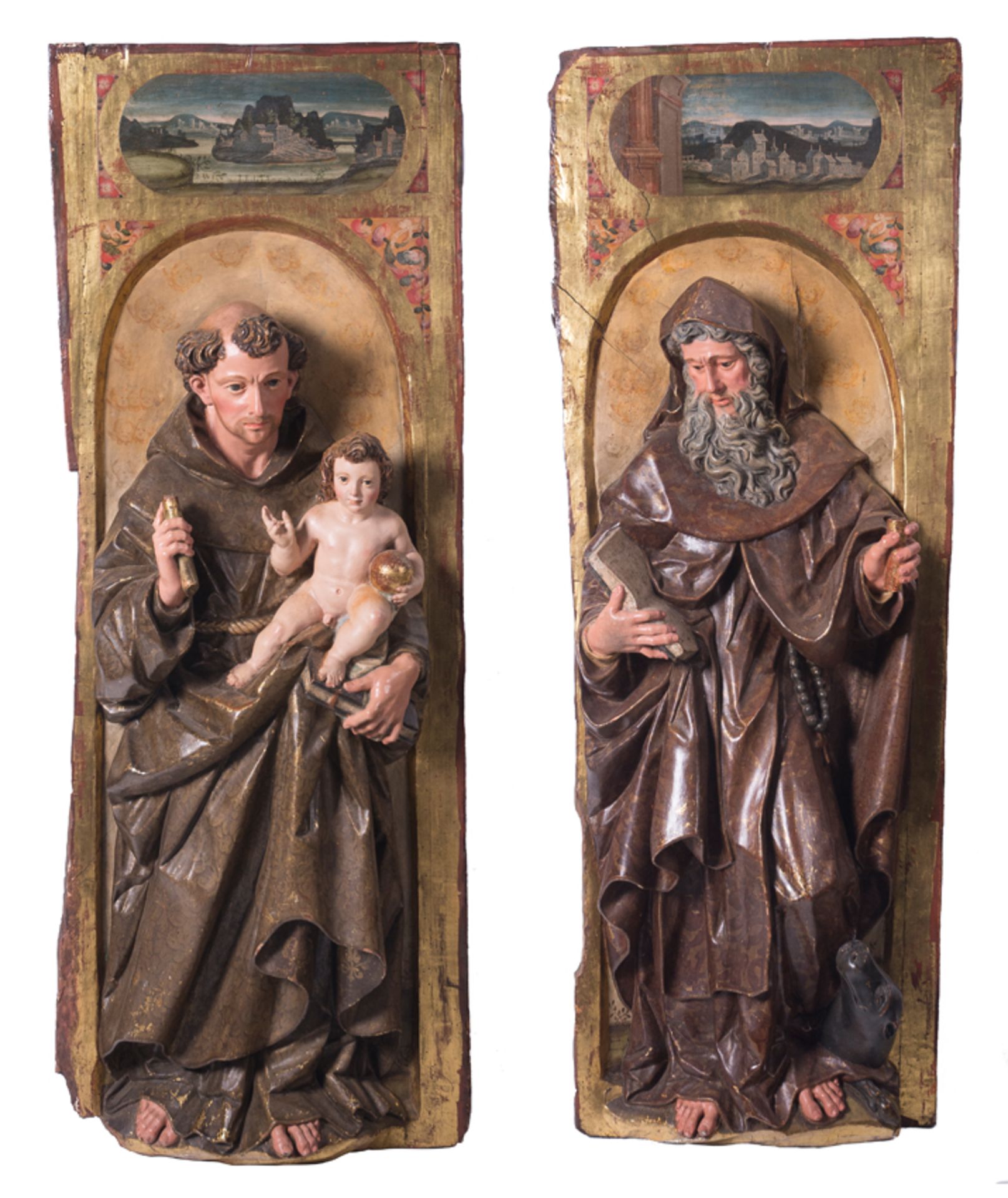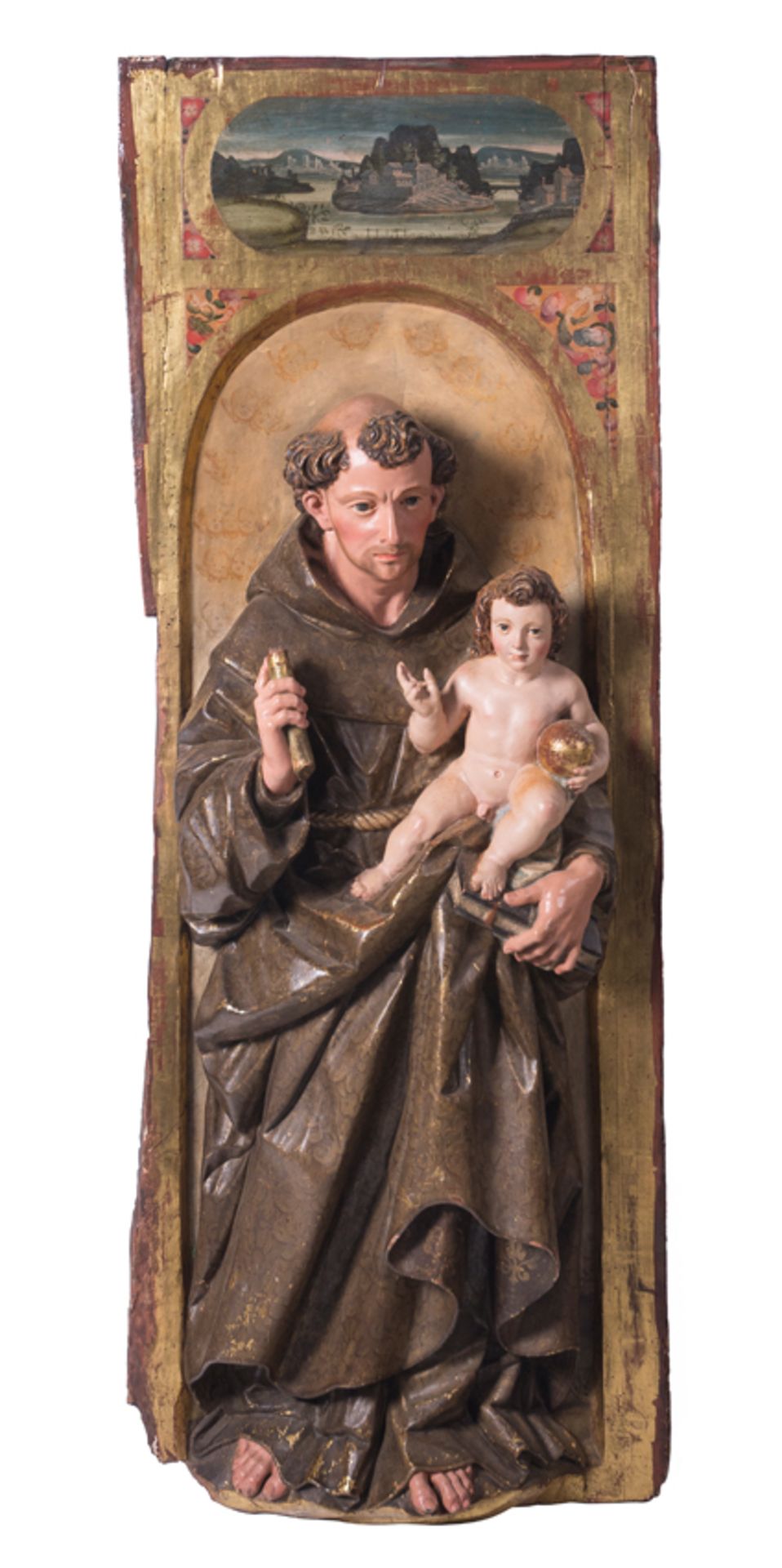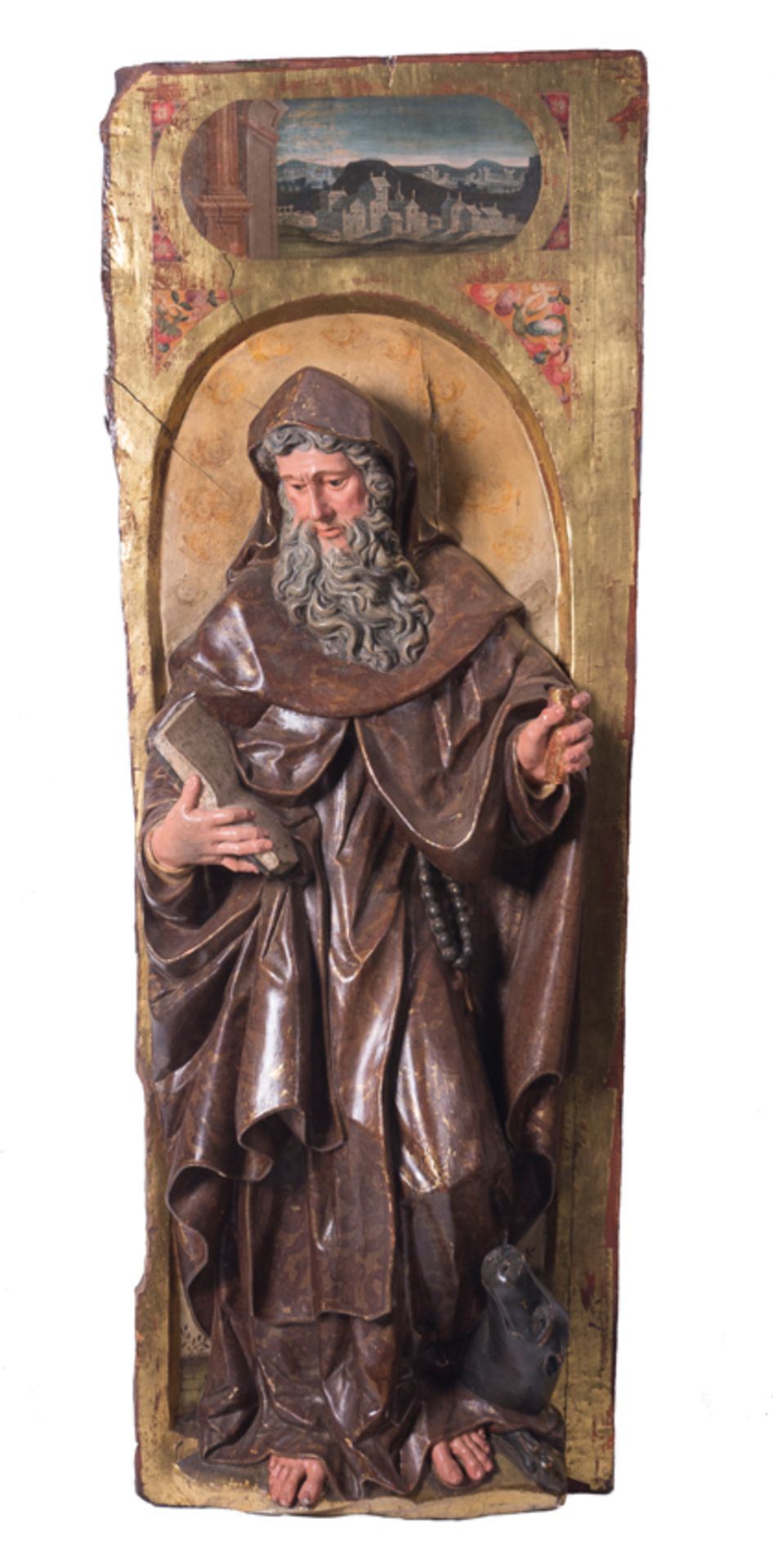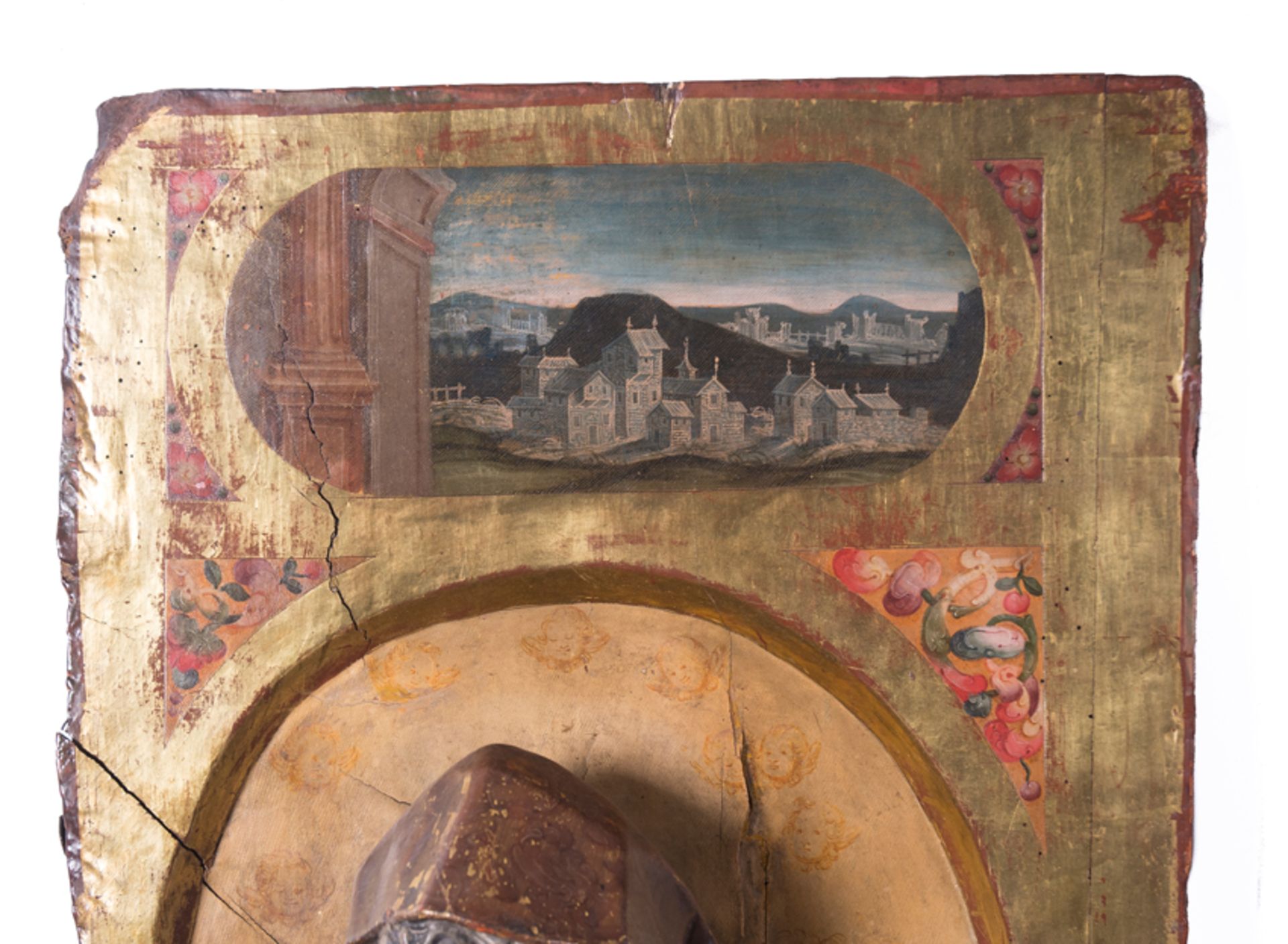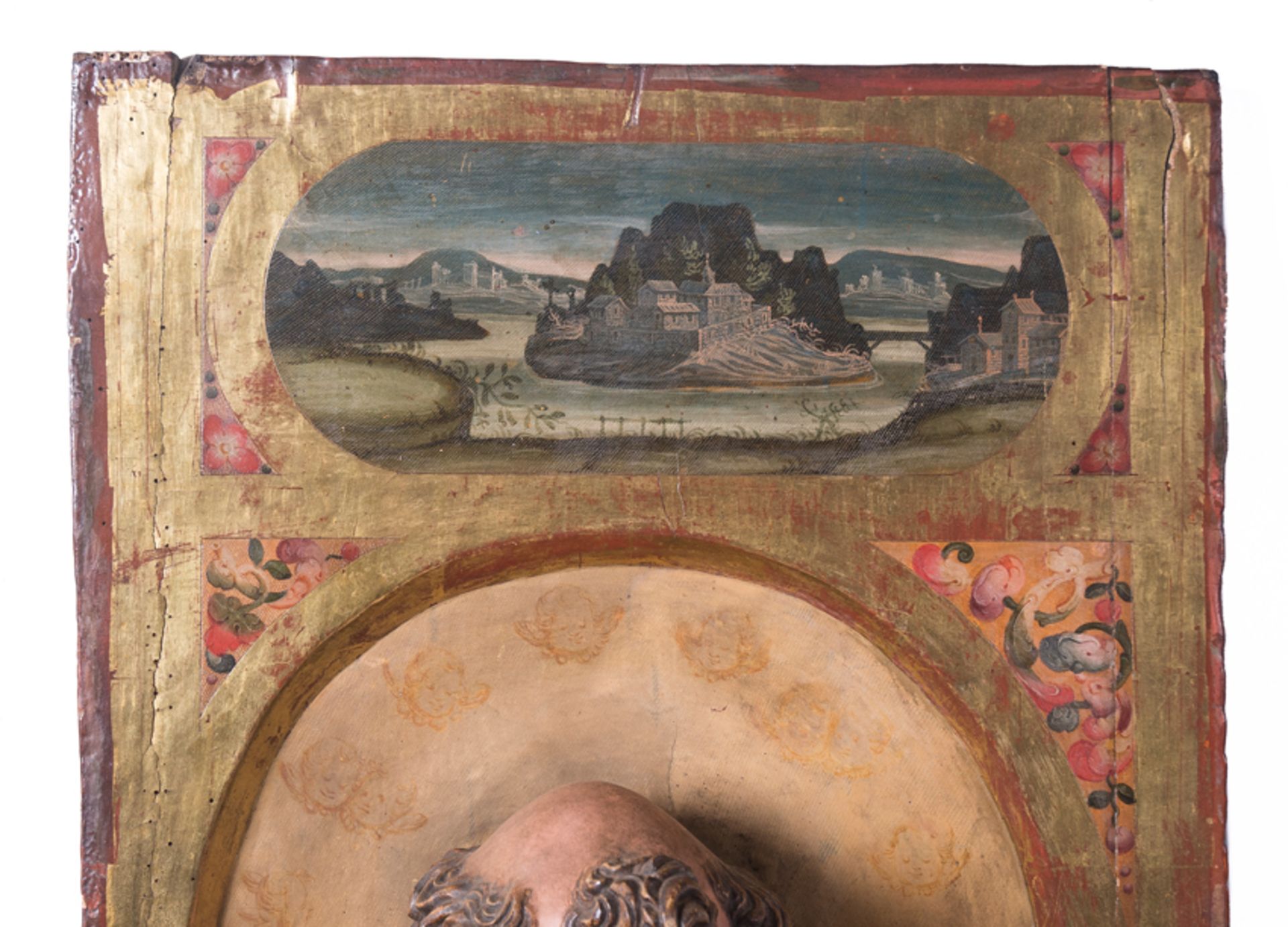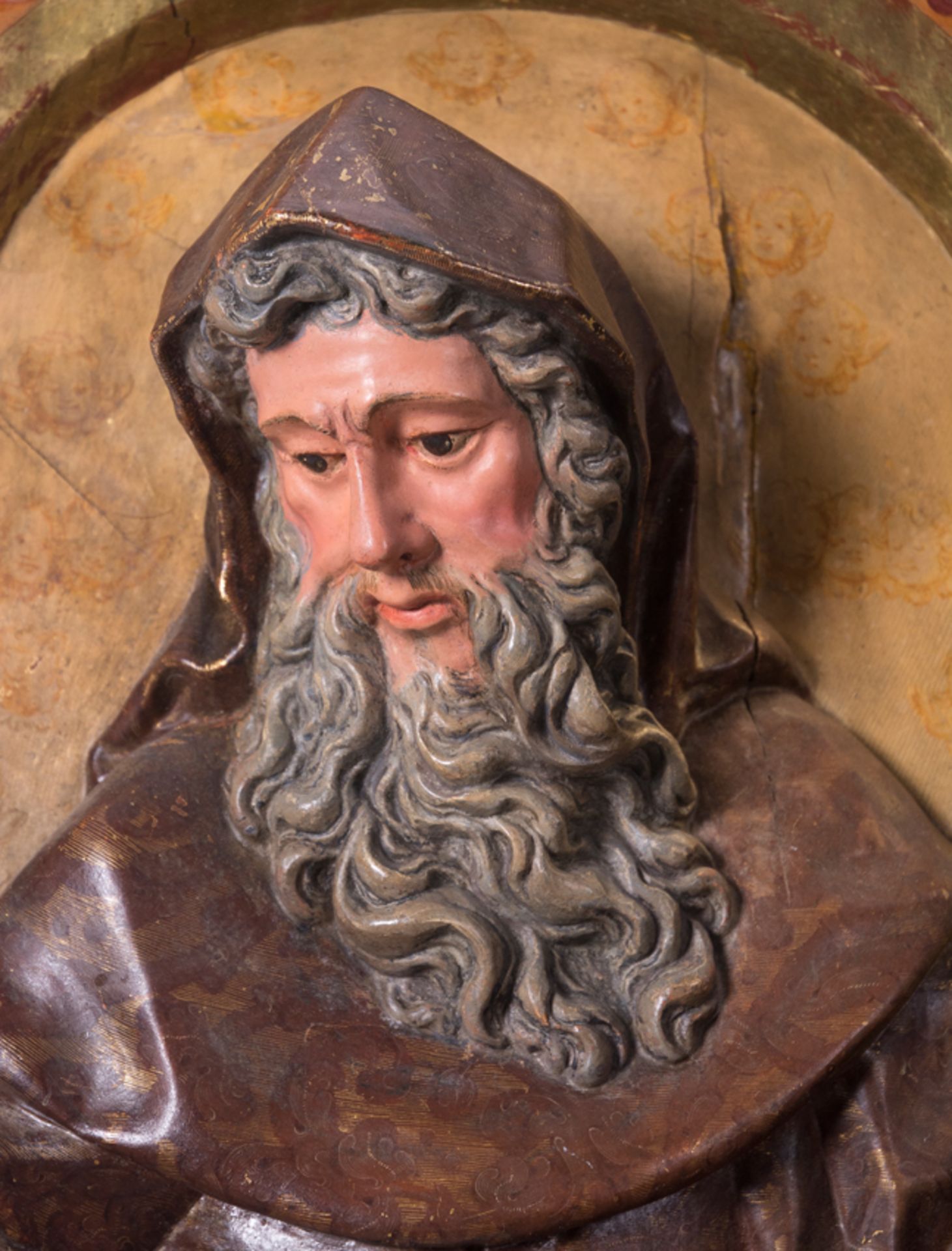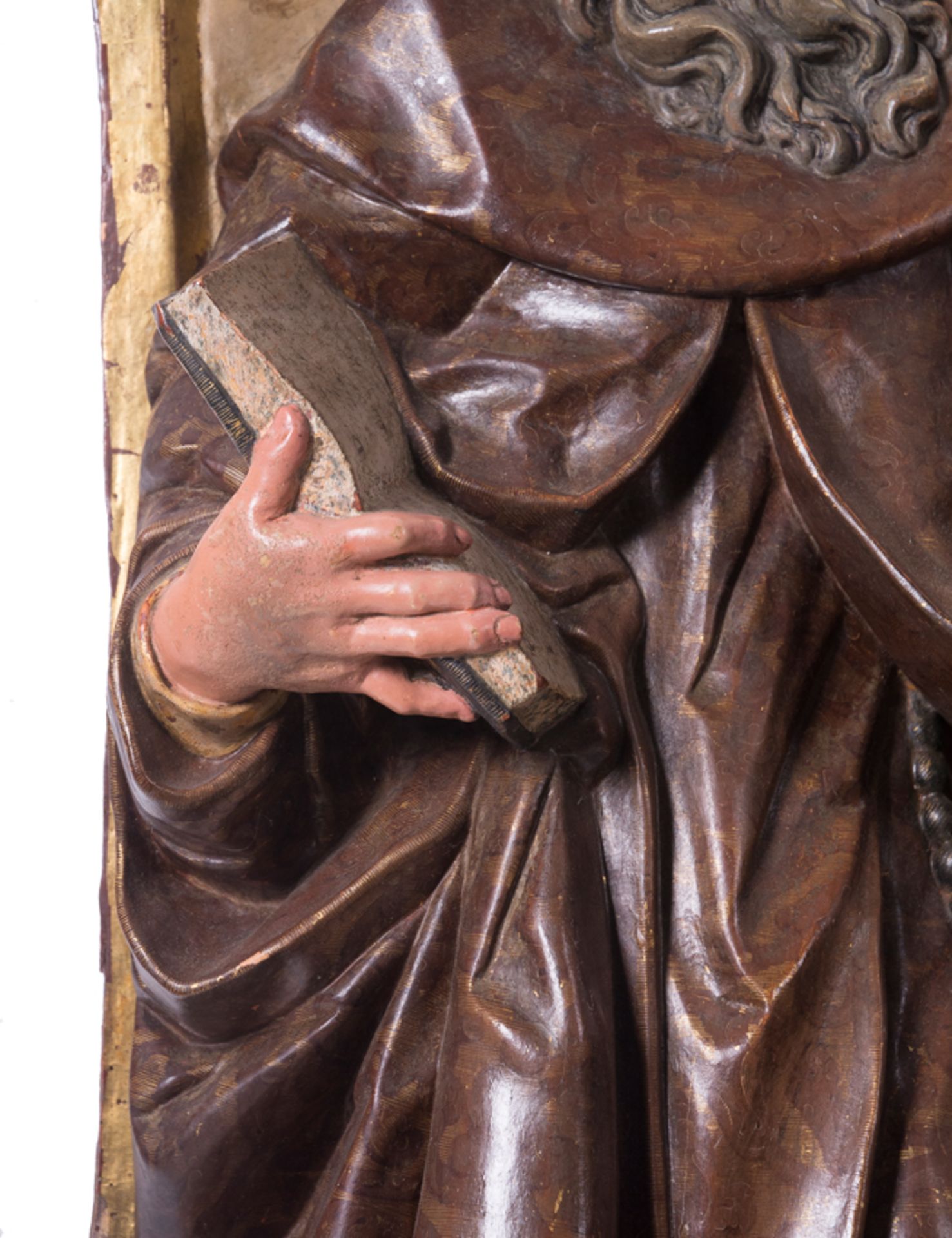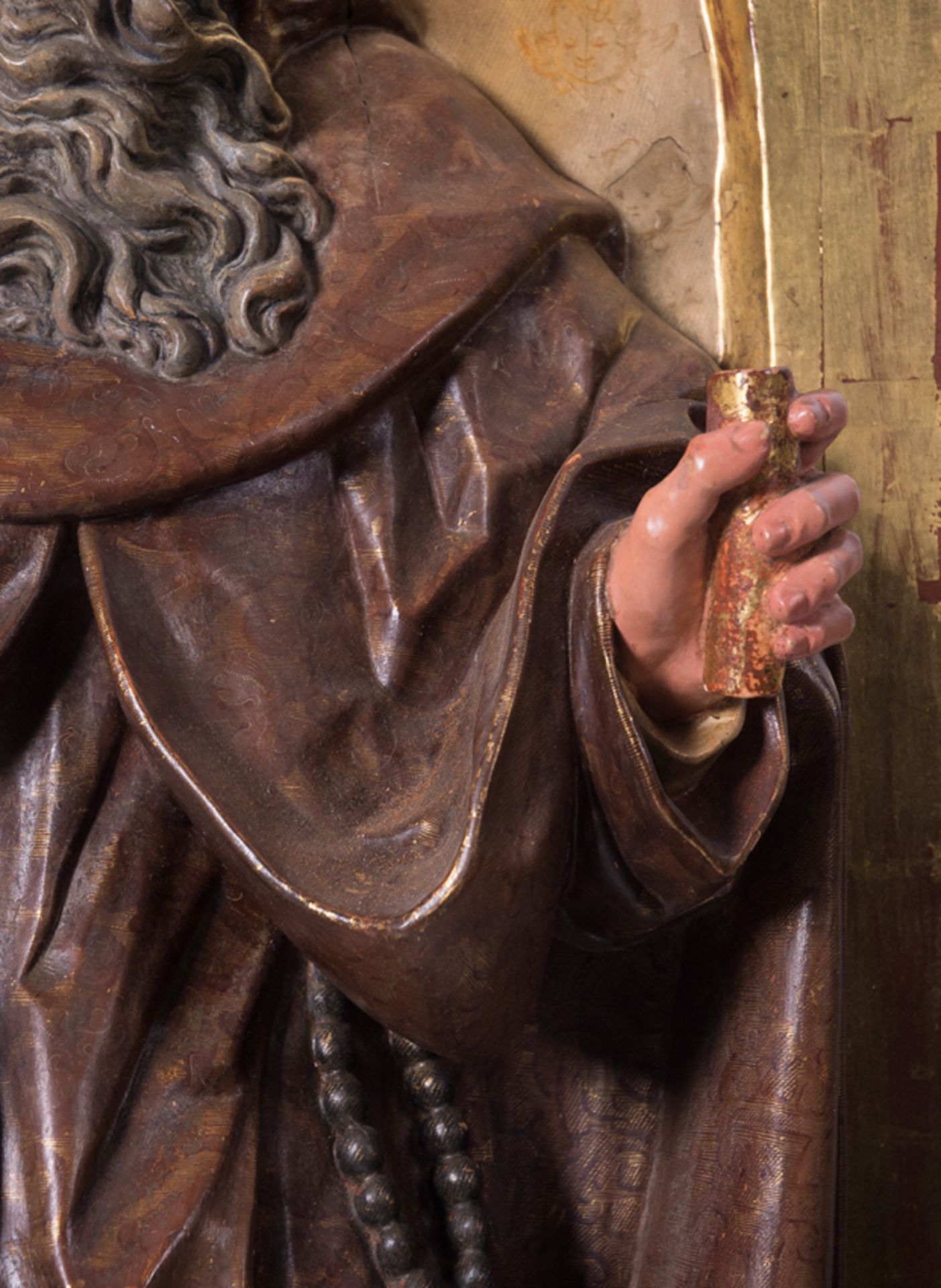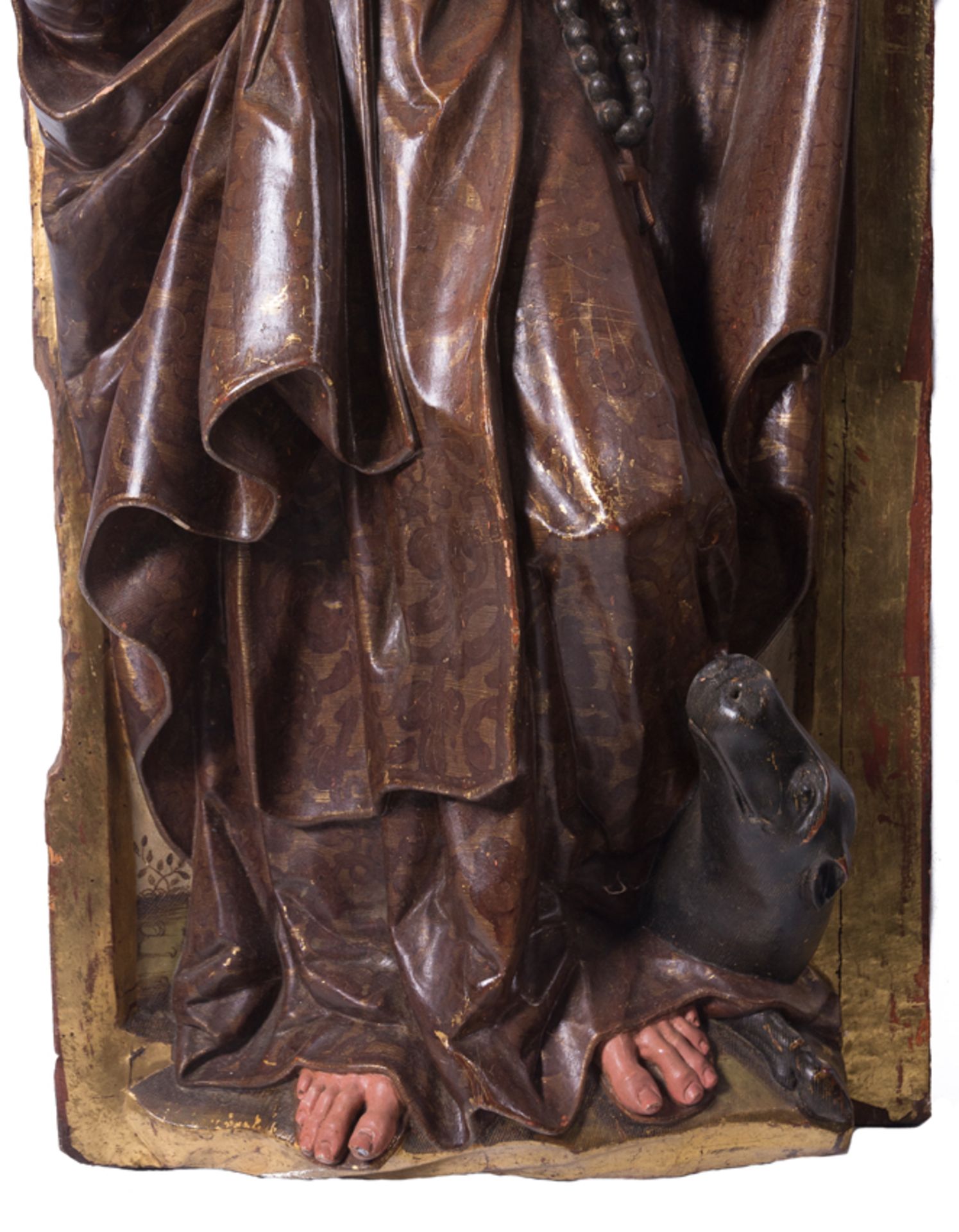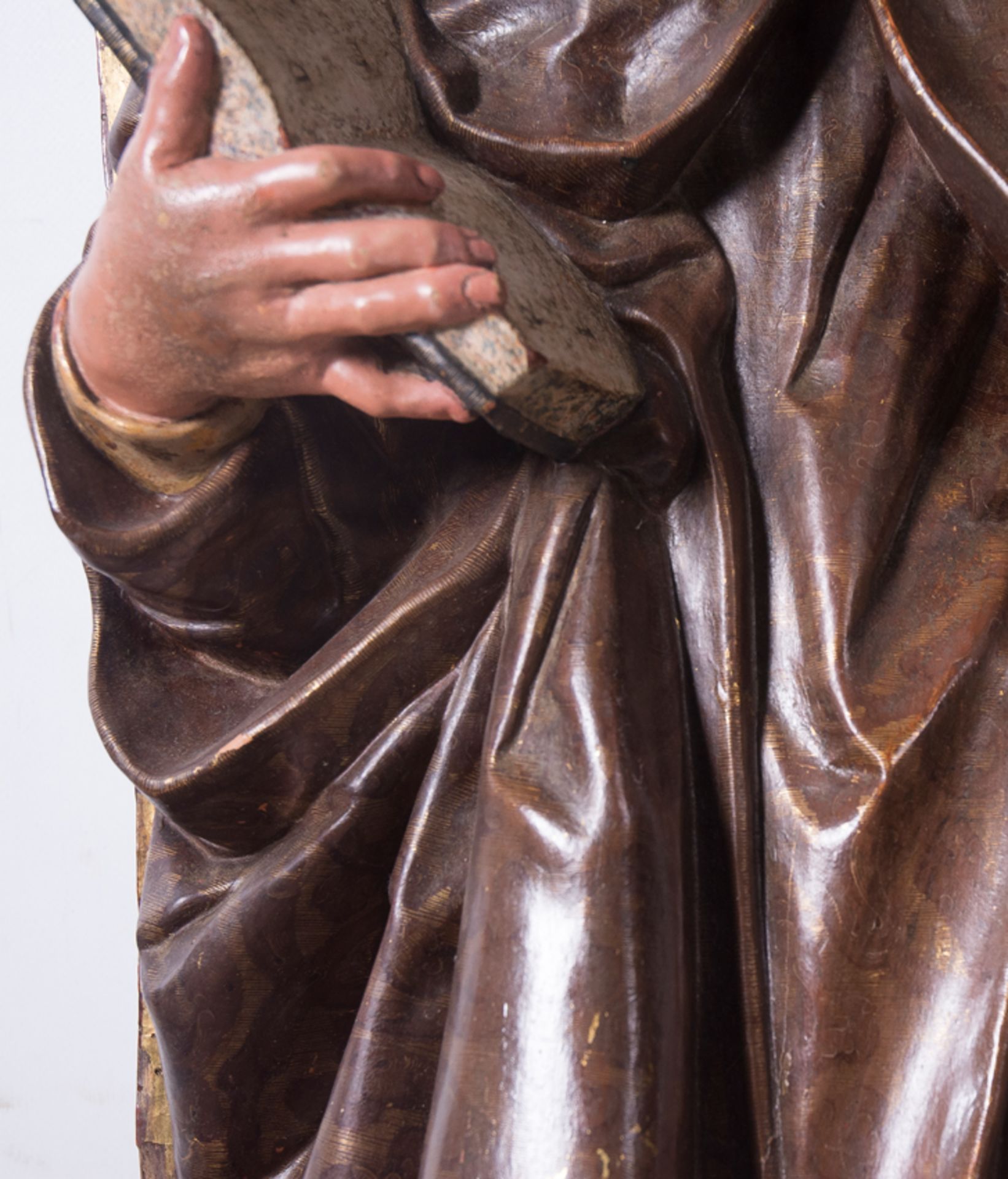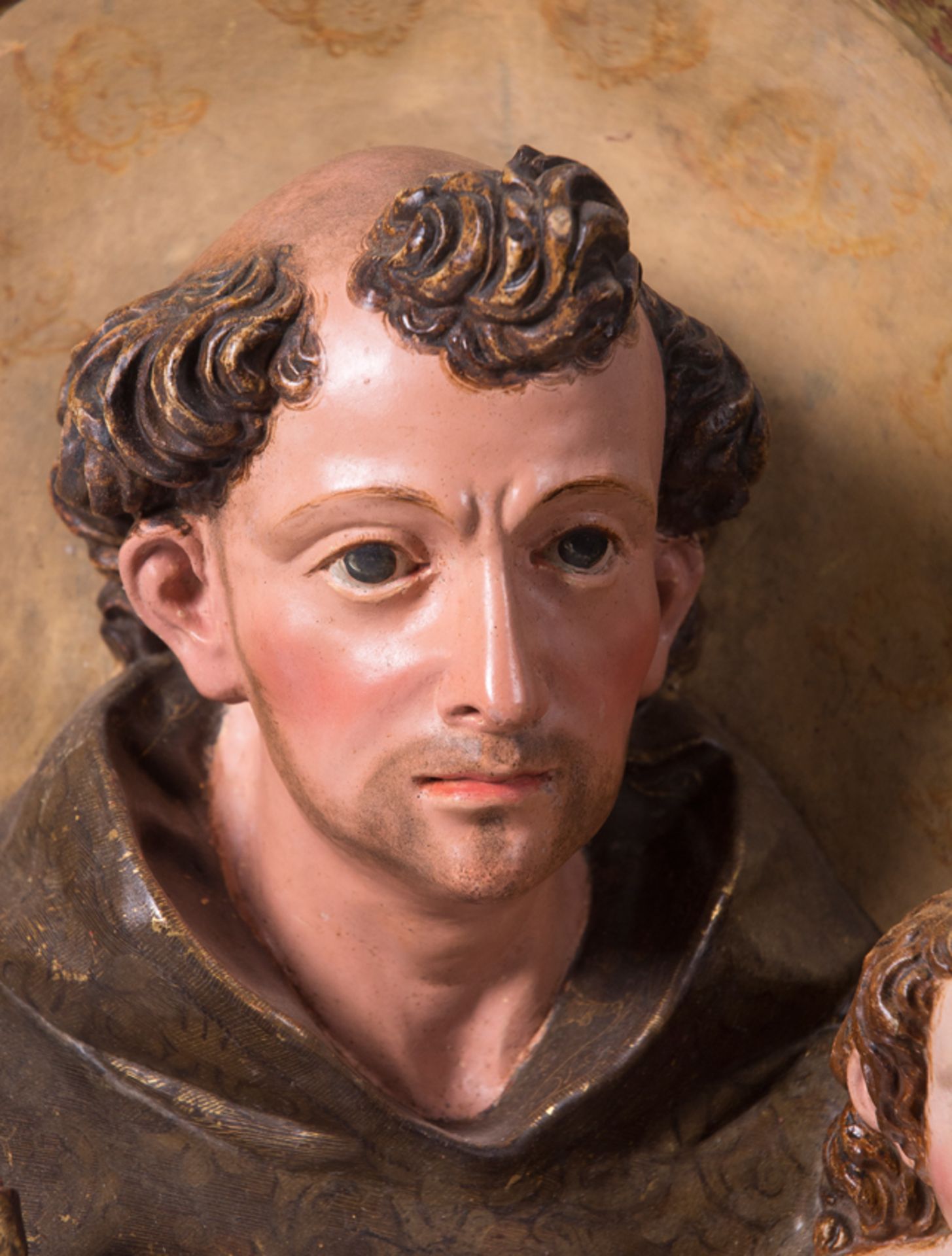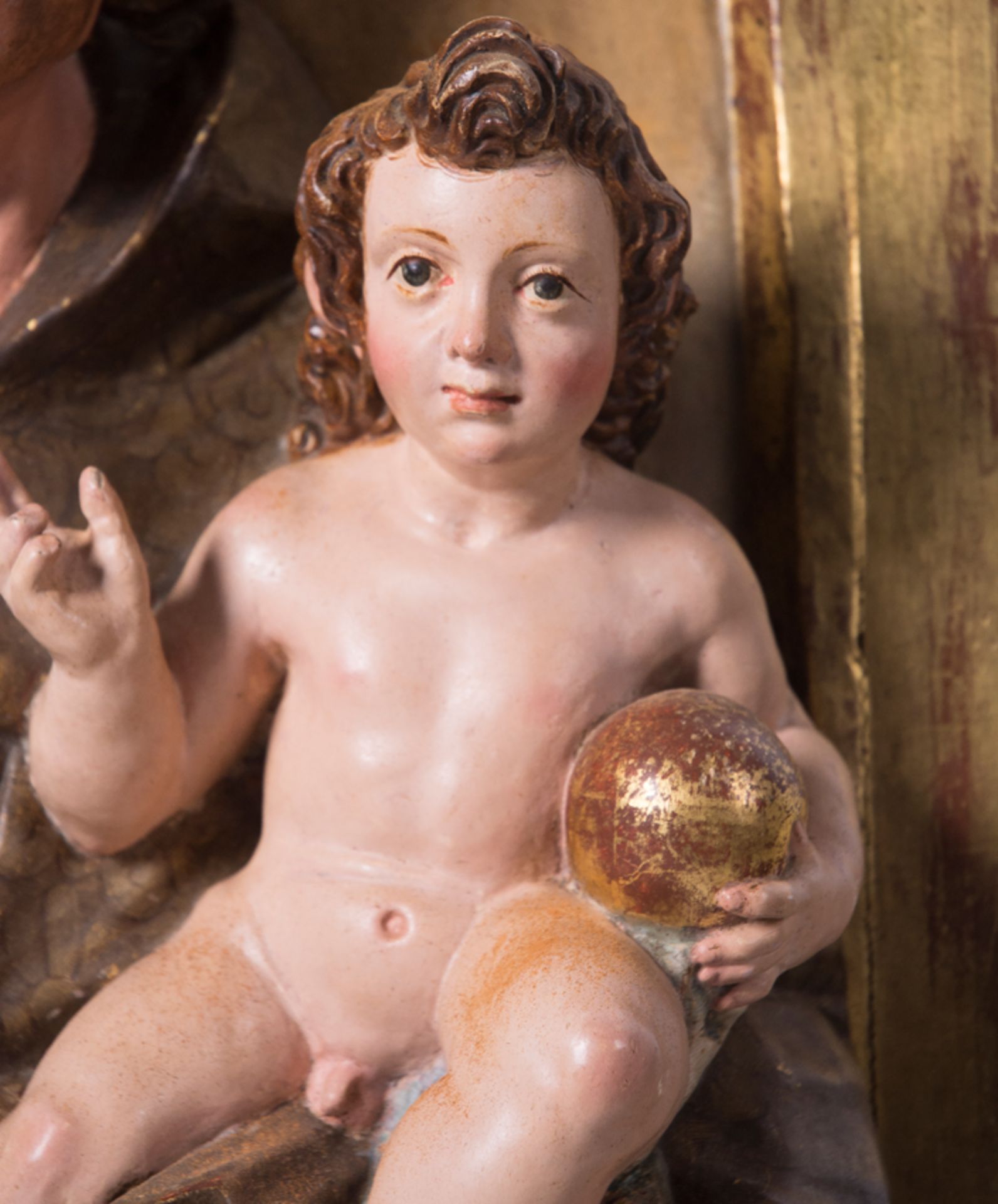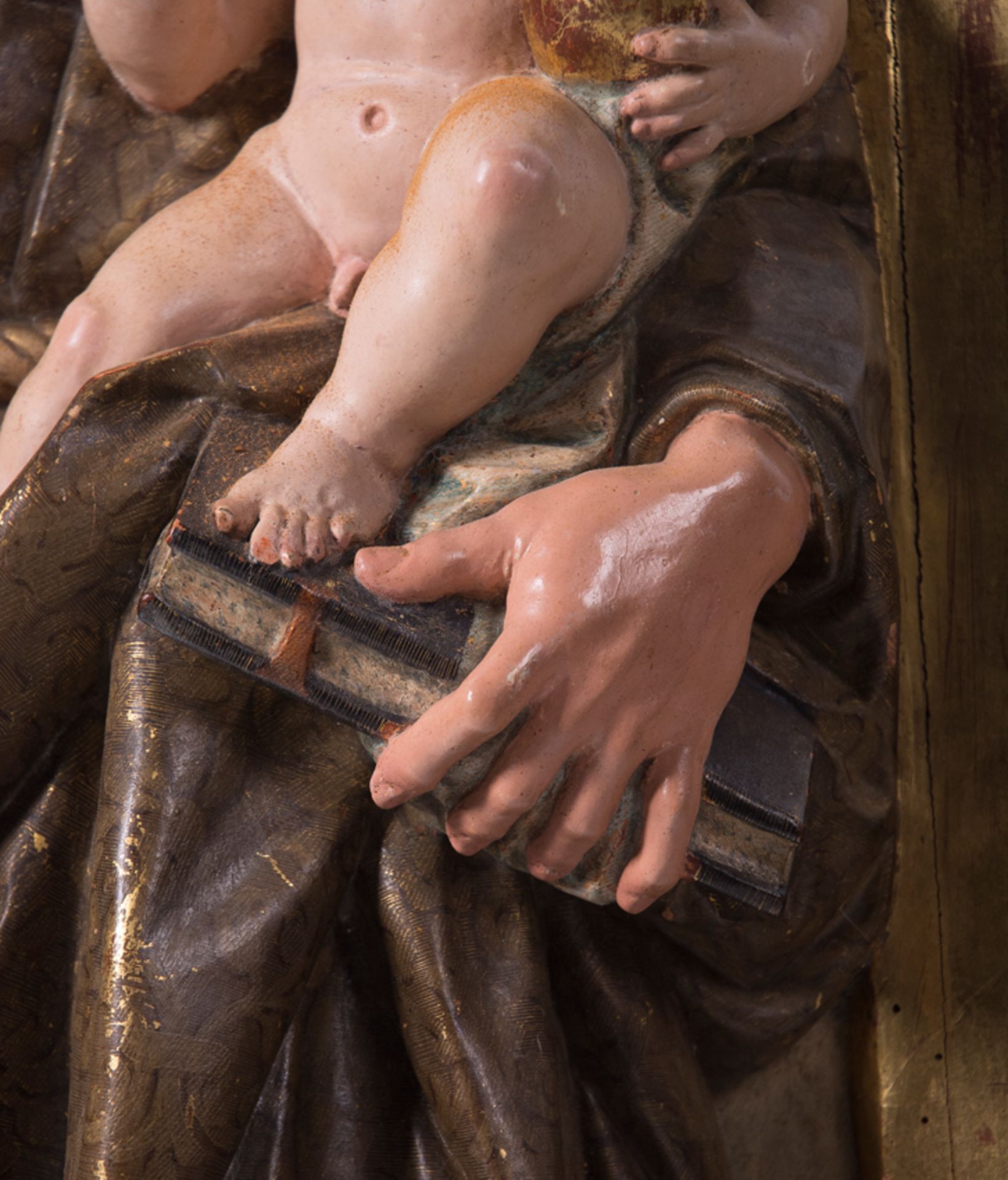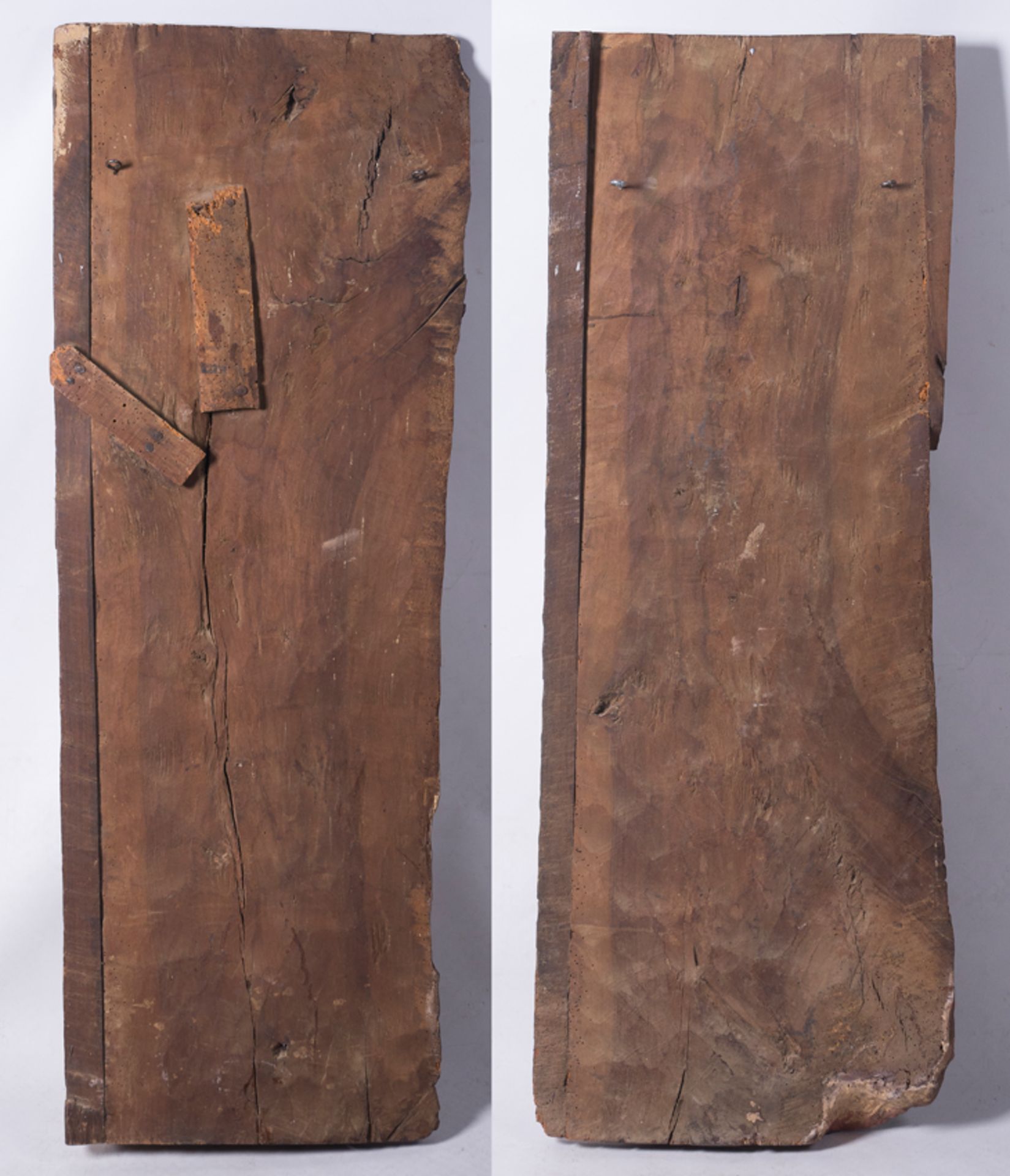68
"S. Anthony the Great and S. Anthony of Padua with the Christ Child". Pair of carved, gilded, estof
“Saint Anthony the Great and Saint Anthony of Padua”. Pair of carved, gilded, estofado and polychromed wooden reliefs. Anonymous Castilian Romanist. Circa 1600.
Measurements "Anthony the Great": 123 x 46 x 15 cm. Measurements "Anthony of Padua": 120 x 43 x 14 cm.
As occurs on numerous occasions with the Saint Johns – Saint John the Baptist and Saint John the Evangelist - they also often appear together on altarpieces due to their common name. For the same reason, Saint Anthony of Padua and Saint Anthony the great, who have little to do with each other beyond their condition as monks, are also often portrayed together. These two panels, presided over by the aforementioned saints, and topped by landscapes in a horizontal format with rounded ends, undoubtedly belonged to a disassembled altarpiece and these could well have been from the between-section.
The two sculptures, made in a high-relief that is almost freestanding, have a marked Romanist style, in which the distant influences of Juan de Juni (1506-1577), mainly present in the Valladolid area, and Juan de Montejo ( h.1540-1601), a sculptor who worked mainly for the dioceses of Zamora and Salamanca, seem to be combined. Indeed, this Romanist component is perceptible in the way the powerful anatomies are conceived, the severe gestures of their faces, the profuse and tangled beard of Saint Anthony the great, or the folds in his garments, although the latter seem somewhat more advanced. For all these reasons, and because of the pictorial decorations, it is possible to date these pieces to around the year 1600 and deduce that they were made by a leading Castilian workshop, perhaps from Salamanca or Zamora, although this cannot be confirmed with certainty.
Both saints have been depicted by the anonymous sculptor according to their best-known iconographies, and with their most typical attributes. Saint Anthony the Great (251-356) was a Christian monk, hermit and father of monasticism. Legend has it that he experienced a series of diabolical temptations in the desert. The saint is represented as an old man with a long beard who wears a brownish sackcloth habit with a hood, a common garment for the monks of his order (the Antonites). This hospital order, founded in the 11th century, had the function of healing diseases: Saint Anthony’s fire, the plague and syphilis. Due to the large number of establishments opened by this order, the cult of its "founder" spread rapidly during the Middle Ages. Saint Anthony is a standing figure, with his left leg slightly forward. He wears sackcloth, with a belt from which hangs a rosary, and a large hooded cape of the same colour. In his left hand he carries an open book, which he reads attentively, while in the other hand he holds an element of which only the handle remains –it would certainly have been a cane with the tau (the tau or potentized cross was the symbol of the afterlife in ancient Egypt, the saint's homeland)–. From this cane, which he used as a staff, a small bell would have hung, an attribute of the hermits, which he would use to repel the attacks of demons, who fled in fear when they heard the sound. The book, from which the flames of the fire of Saint Anthony sometimes emerge, would have been the Rule of the Antonites. The pig is at the feet of the saint, which are, of course, barefoot. The pig is his most characteristic iconographic element, in addition to being his inseparable companion, and rubs against him as a symbol of brotherhood.
Saint Anthony of Padua was born as Fernando de Bulhões, and was the second most important personality of the Franciscan Order, as well as an outstanding theologian and preacher. The figure is standing, dressed in the Franciscan habit, with a wide neck and cuffs, cinched at the waist by the characteristic chord of the Order. As with other saints, the physiognomy with which he is represented has nothing to do with his real-life face. In his left hand he holds a book on which rests a Christ Child –his most common iconography- that alludes to the appearance of the Madonna and Child to the saint in his room. In it the Mother offers him to her beloved Son. Apparently, this vision is a transposition of the Apparition of Christ Seraphim to Saint Francis of Assisi. The Child, with a muscular anatomy, unstable posture and powerful curly hair with a tuft at the front, holds the orb in his left hand while giving blessing with his right. In the saint's right hand, which is elevated, he could well have displayed a bouquet of lilies, a symbol of purity, in addition to being another of his most usual attributes.
We end this description with the two delicious landscapes conceived almost as grisailles, although they are not, since they use a wider range of colours, although reduced to greens, greys and blues. Both present a combination of cities with mountainous landscapes, and in which overcast skies take pride of place. The one above Saint Anthony the Great appears to be a perspective taken from some classical ruins that appear in the foreground, on the left side is a column that rests on a pedestal, and next to it is a pilaster that seems to have formed the base of a missing arch. The landscape above Saint Anthony of Padua differentiates itself by showing a dispersion of different nuclei of houses, one of which has been arranged on a kind of island connected to the mainland by a simple bridge, in this representation the element of water is of great importance.
We cannot end without mentioning the triangular botanical decorations located in the spandrels of the arch that frame the saints, and also to the mouldings that frame the aforementioned small and gorgeous paintings.
“Saint Anthony the Great and Saint Anthony of Padua”. Pair of carved, gilded, estofado and polychromed wooden reliefs. Anonymous Castilian Romanist. Circa 1600.
Measurements "Anthony the Great": 123 x 46 x 15 cm. Measurements "Anthony of Padua": 120 x 43 x 14 cm.
As occurs on numerous occasions with the Saint Johns – Saint John the Baptist and Saint John the Evangelist - they also often appear together on altarpieces due to their common name. For the same reason, Saint Anthony of Padua and Saint Anthony the great, who have little to do with each other beyond their condition as monks, are also often portrayed together. These two panels, presided over by the aforementioned saints, and topped by landscapes in a horizontal format with rounded ends, undoubtedly belonged to a disassembled altarpiece and these could well have been from the between-section.
The two sculptures, made in a high-relief that is almost freestanding, have a marked Romanist style, in which the distant influences of Juan de Juni (1506-1577), mainly present in the Valladolid area, and Juan de Montejo ( h.1540-1601), a sculptor who worked mainly for the dioceses of Zamora and Salamanca, seem to be combined. Indeed, this Romanist component is perceptible in the way the powerful anatomies are conceived, the severe gestures of their faces, the profuse and tangled beard of Saint Anthony the great, or the folds in his garments, although the latter seem somewhat more advanced. For all these reasons, and because of the pictorial decorations, it is possible to date these pieces to around the year 1600 and deduce that they were made by a leading Castilian workshop, perhaps from Salamanca or Zamora, although this cannot be confirmed with certainty.
Both saints have been depicted by the anonymous sculptor according to their best-known iconographies, and with their most typical attributes. Saint Anthony the Great (251-356) was a Christian monk, hermit and father of monasticism. Legend has it that he experienced a series of diabolical temptations in the desert. The saint is represented as an old man with a long beard who wears a brownish sackcloth habit with a hood, a common garment for the monks of his order (the Antonites). This hospital order, founded in the 11th century, had the function of healing diseases: Saint Anthony’s fire, the plague and syphilis. Due to the large number of establishments opened by this order, the cult of its "founder" spread rapidly during the Middle Ages. Saint Anthony is a standing figure, with his left leg slightly forward. He wears sackcloth, with a belt from which hangs a rosary, and a large hooded cape of the same colour. In his left hand he carries an open book, which he reads attentively, while in the other hand he holds an element of which only the handle remains –it would certainly have been a cane with the tau (the tau or potentized cross was the symbol of the afterlife in ancient Egypt, the saint's homeland)–. From this cane, which he used as a staff, a small bell would have hung, an attribute of the hermits, which he would use to repel the attacks of demons, who fled in fear when they heard the sound. The book, from which the flames of the fire of Saint Anthony sometimes emerge, would have been the Rule of the Antonites. The pig is at the feet of the saint, which are, of course, barefoot. The pig is his most characteristic iconographic element, in addition to being his inseparable companion, and rubs against him as a symbol of brotherhood.
Saint Anthony of Padua was born as Fernando de Bulhões, and was the second most important personality of the Franciscan Order, as well as an outstanding theologian and preacher. The figure is standing, dressed in the Franciscan habit, with a wide neck and cuffs, cinched at the waist by the characteristic chord of the Order. As with other saints, the physiognomy with which he is represented has nothing to do with his real-life face. In his left hand he holds a book on which rests a Christ Child –his most common iconography- that alludes to the appearance of the Madonna and Child to the saint in his room. In it the Mother offers him to her beloved Son. Apparently, this vision is a transposition of the Apparition of Christ Seraphim to Saint Francis of Assisi. The Child, with a muscular anatomy, unstable posture and powerful curly hair with a tuft at the front, holds the orb in his left hand while giving blessing with his right. In the saint's right hand, which is elevated, he could well have displayed a bouquet of lilies, a symbol of purity, in addition to being another of his most usual attributes.
We end this description with the two delicious landscapes conceived almost as grisailles, although they are not, since they use a wider range of colours, although reduced to greens, greys and blues. Both present a combination of cities with mountainous landscapes, and in which overcast skies take pride of place. The one above Saint Anthony the Great appears to be a perspective taken from some classical ruins that appear in the foreground, on the left side is a column that rests on a pedestal, and next to it is a pilaster that seems to have formed the base of a missing arch. The landscape above Saint Anthony of Padua differentiates itself by showing a dispersion of different nuclei of houses, one of which has been arranged on a kind of island connected to the mainland by a simple bridge, in this representation the element of water is of great importance.
We cannot end without mentioning the triangular botanical decorations located in the spandrels of the arch that frame the saints, and also to the mouldings that frame the aforementioned small and gorgeous paintings.
Images. The Divine and the Human
Auktionsdatum
Ort der Versteigerung
Generelle Versandinformationen vom Auktionshaus verfügbar
The purchase price includes the delivery of the lots in the venue of the auction. Transporting to other destinations is at the own risk of the client. The customer must contact "LST", to give the corresponding instructions for such transporting. "LST" is not responsible for the packaging or any accident incurred during transportation.
Wichtige Informationen
Aufgeld / Premium: 22 %
Live: 3 %
jeweils zusätzlich USt. / both plus VAT: 21 %
AGB
CONDITIONS OF THE AUCTION:
I. REGISTRATION. To bid in the room customers must register at the beginning, filling out a form and picking a number that will identify them during the auction. Customers may be required to register in bank references or other guarantee system and if they do not prove the solvency "LST" will not accept bids and award the auction.
II. WRITTEN BIDS. "LST" will accept written bids, which will be formalized in the form provided by the room until the day before the auction. In such auctions, the room will bid in name of the client until the maximum stated in the offer and always at the lowest possible price. If there are two or more bids for the same amount, the one placed first will have the priority. Written bids received in advance, will have priority on the day of the auction.
III. TELEPHONE BIDS. "LST" will allow telephone bids, if interested people contact "LST" days before the auction providing personal data, ID card and the phone number which will be used by the staff of "LST" to call at the time of the auction. The buyer, within all the legal rights is making an offer for the asking price, when applies for telephone bid. "LST" will not take responsibility for any technical defects beyond its control, which may prevent to contact successfully the bidder during the auction.
IV. AUCTIONEER. The auction will be conducted by an auctioneer, director of the auction will be judge and arbitrator of it with full authority in its development, will award the lots to the highest bidder and is able to settle any controversy concerning lots sale, reject bids, divide lots or group them and remover objects from the room. Will be able to, if it is deemed suitable, not accept bids on the auction. His decision will be unappealable.
V. SALE OF LOTS. The lots are awarded to the highest bidder. Once the auctioneer blows the hammer, the buyer becomes responsible of the lot purchased, exempting "LST" of liability to for any damage and / or accidents that may occur. No refunds of lots.
VI. STARTING PRICE. The amount shown in the catalogue as the starting price for each lot will be, as a rule, the minimum selling price, except for exceptional cases where a reservation may be agreed upon with the seller or it set discretionary by the room.
VII. SCALE OF BIDS. The bids are set according to the following scale:
From 50.-€ to 200.-€…………………………………………..at 10.-€
From 200.-€ to 500.-€…………………………………… …25 in 25.-€
From 500.-€ to 1.000.-€………………………………..…..….50 in 50.-€
From 1.000.-€ to 2.000.-€………………………………..…100 in 100.-€
From 2.000.-€ to 5.000.-€……………………………….….250 in 250.-€
From 5.000.-€ to 10.000.-€…………………………………500 in 500.-€
From 10.000.-€ to 20.000.-€……………………………1.000 in 1.000.-€
From 20.000.-€ to 50.000.-€……………………………2.500 in 2.500.-€
From 50.000.-€ to 100.000.-€…………………………..5.000 in 5.000.-€
From 100.000.-€ to 100.000.-€………………………10.000 in 10.000.-€
From 200.000.-€ to 200.000.-€………………………25.000 in 25.000.-€
From 500.000.-€ to 500.000.-€………………………50.000 in 50.000.-€
VIII. RIGHT OF ADMISION. "LST" reserves the right to admission to the auction room and to reject, at its judgment, any purchase order, from clients whose solvency is not duly proved as well as not to sale auctions.
IX. SALE PRICES. The successful bidder of one or more lots must pay "LST" the final sale price achieves at auction, plus the 22 % plus 21% VAT on the commission, at total 26,62 % on Hammer Price.
X. CATALOG DATA. The catalogue data are obtained in order to careful research and advice, however, any responsibility is afforded about its accuracy. The lots will be auctioned in the state in which they are, not accepting any claims in restorations, breakage, damage, imperfections and, even description or numbering mistakes in the catalogue, in case of it, being the burden of the buyers to make sure before the auction that the description matches with their personal opinion about respective lot. The exhibition of the lots is intended to allow a perfect review and study of them.
XI. PAYMENT AND REMOVAL OF LOTS. Payment and removal of the lots will be held no later than five days following the auction. After this period expire without having the buyer removed the lot or lots purchases, it will accrue an expense of custody of 6 euros per day on each lot.
15 days after the auction without having the buyer paid and removes the sold lots, "LST" will inform the seller and there will begin judicial proceeding in order to obtain payment. The delay in payment by the purchaser of his/her sold lots will carry an interest increase at a rate of 1,5% per month.
XII. DELIVERY OF LOTS. The purchase price includes the delivery of the lots in the venue of the auction. Transporting to other destinations is at the own risk of the client. The customer must contact "LST", to give the corresponding instructions for such transporting. "LST" is not responsible for the packaging or any accident incurred during transportation.
XIII. RIGHT OF FIRT REFUSAL AND REPURCHASE. "LST" in order to article 38 of "Ley 16/1985 de 25 Junio del Patrimonio Histórico Español" (BOE. 155 June 29, 1985), will notify in advance to the Ministry of Culture, the content of their catalogues. Concerning the lots subject to the legislation referred to in the preceding paragraph, the Administration may exercise the rights of first refusal and repurchase according to the law. "LST" will watch over the protection of Artistic, Historical and Bibliographical Heritage of Spain. For customers out of European Community, a tax for export is required by the Administration.
XIV. VALUE ADDED TAX (I.V.A). This tax will be accrued on commissions of "LST" for buyers, using the rates prevailing on the date of the auction.
XV. DATA PROTECTION. In order to the "Ley 15/1999 de 13 de Diciembre, de Protección de Datos de Carácter Personal", the client authorize "LST", the inclusion of their data in a customer file, and for the promotion by "LST" of the objects at all times the rights of access, rectification or deletion of personal data by sending the appropriate request to the following address: LA SUITE SUBASTAS, C/ Conde Salvatierra, 8, 08006. Barcelona.
XVI. EXPRESS LEGAL JURISDICTION. These Conditions are governed by and interpreted in accordance with the rules of Spanish law. The mere act of participating in the auction as seller, buyer or bidder, implies acceptance of these Terms and Conditions.
Sales operations are understood to be held at the registered office of "LST", C/ Conde de Salvatierra, 8, 08006. Any dispute shall be taken to the competent courts of Barcelona, expressly waiving any other jurisdiction, in accordance with Article 55 of the "Ley de Enjuiciamiento Civil".




































